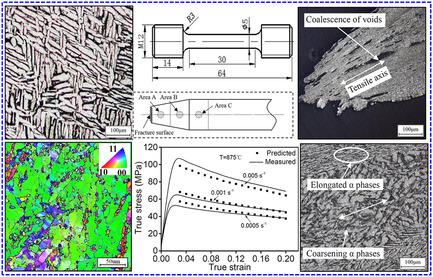当前位置:
X-MOL 学术
›
Adv. Eng. Mater.
›
论文详情
Our official English website, www.x-mol.net, welcomes your
feedback! (Note: you will need to create a separate account there.)
Hot Tensile Deformation Mechanism and Dynamic Softening Behavior of Ti–6Al–4V Alloy with Thick Lamellar Microstructures
Advanced Engineering Materials ( IF 3.4 ) Pub Date : 2019-12-17 , DOI: 10.1002/adem.201901193 Y. C. Lin 1, 2 , Qiao Wu 1 , Guo-Dong Pang 2 , Xing-You Jiang 1 , Dao-Guang He 1, 2
Advanced Engineering Materials ( IF 3.4 ) Pub Date : 2019-12-17 , DOI: 10.1002/adem.201901193 Y. C. Lin 1, 2 , Qiao Wu 1 , Guo-Dong Pang 2 , Xing-You Jiang 1 , Dao-Guang He 1, 2
Affiliation

|
The deformation mechanisms and dynamic softening behavior of a Ti–6Al–4V alloy with thick lamellar microstructures are studied by uniaxial hot tensile tests. The true stress first rapidly reaches a peak value because of the rapid dislocations proliferation and tangle, and then gradually decreases due to the dynamic softening with raising the deformation amount. The dynamic softening behavior is mainly induced by the severe dynamic globularization of lamellar α phases. The globularization of α phase is always accompanied by the formation of high‐angle grain boundaries (HAGBs). The fraction of globularized α phases increases with the increasing deformation temperature. The fracture mechanism is microvoid coalescence, i.e., in the initial stage of tensile deformation, the microvoids begin to emerge. With the increasing deformation amount, the number of microvoids increases, and the microvoids accumulate and accelerate to propagate until the final fracture. According to the experimental flow stress curves, a modified Arrhenius‐type equation and a Hensel–Spittel (HS) model are developed to forecast the flow stresses. The average absolute relative error of the established strain‐compensated Arrhenius‐type (SCAT) and HS models are 6.108% and 3.385%, respectively. Both models can be well used to describe the hot tensile flow characteristics of the Ti–6Al–4V alloy with thick lamellar microstructures.
中文翻译:

厚层状Ti-6Al-4V合金的热拉伸变形机理和动态软化行为
通过单轴热拉伸试验研究了具有较厚层状微结构的Ti-6Al-4V合金的变形机理和动态软化行为。由于位错的快速扩散和缠结,其真实应力首先迅速达到峰值,然后由于动态软化而随着变形量的增加而逐渐减小。动态软化行为主要是由层状α相的剧烈动态球化引起的。α相的球状化总是伴随着高角度晶界(HAGBs)的形成。球状α相的分数随变形温度的升高而增加。断裂机理是微孔聚结,即在拉伸变形的初始阶段,微孔开始出现。随着变形量的增加,微孔的数量增加,并且微孔积累并加速传播,直到最终破裂。根据实验的流动应力曲线,开发了改进的Arrhenius型方程式和Hensel-Spittel(HS)模型来预测流动应力。建立的应变补偿Arrhenius型(SCAT)和HS模型的平均绝对相对误差分别为6.108%和3.385%。两种模型都可以很好地描述具有厚层状微结构的Ti-6Al-4V合金的热拉伸流动特性。建立的应变补偿Arrhenius型(SCAT)和HS模型的平均绝对相对误差分别为6.108%和3.385%。两种模型都可以很好地描述具有厚层状微结构的Ti-6Al-4V合金的热拉伸流动特性。建立的应变补偿Arrhenius型(SCAT)和HS模型的平均绝对相对误差分别为6.108%和3.385%。两种模型都可以很好地描述具有厚层状微结构的Ti-6Al-4V合金的热拉伸流动特性。
更新日期:2019-12-17
中文翻译:

厚层状Ti-6Al-4V合金的热拉伸变形机理和动态软化行为
通过单轴热拉伸试验研究了具有较厚层状微结构的Ti-6Al-4V合金的变形机理和动态软化行为。由于位错的快速扩散和缠结,其真实应力首先迅速达到峰值,然后由于动态软化而随着变形量的增加而逐渐减小。动态软化行为主要是由层状α相的剧烈动态球化引起的。α相的球状化总是伴随着高角度晶界(HAGBs)的形成。球状α相的分数随变形温度的升高而增加。断裂机理是微孔聚结,即在拉伸变形的初始阶段,微孔开始出现。随着变形量的增加,微孔的数量增加,并且微孔积累并加速传播,直到最终破裂。根据实验的流动应力曲线,开发了改进的Arrhenius型方程式和Hensel-Spittel(HS)模型来预测流动应力。建立的应变补偿Arrhenius型(SCAT)和HS模型的平均绝对相对误差分别为6.108%和3.385%。两种模型都可以很好地描述具有厚层状微结构的Ti-6Al-4V合金的热拉伸流动特性。建立的应变补偿Arrhenius型(SCAT)和HS模型的平均绝对相对误差分别为6.108%和3.385%。两种模型都可以很好地描述具有厚层状微结构的Ti-6Al-4V合金的热拉伸流动特性。建立的应变补偿Arrhenius型(SCAT)和HS模型的平均绝对相对误差分别为6.108%和3.385%。两种模型都可以很好地描述具有厚层状微结构的Ti-6Al-4V合金的热拉伸流动特性。










































 京公网安备 11010802027423号
京公网安备 11010802027423号